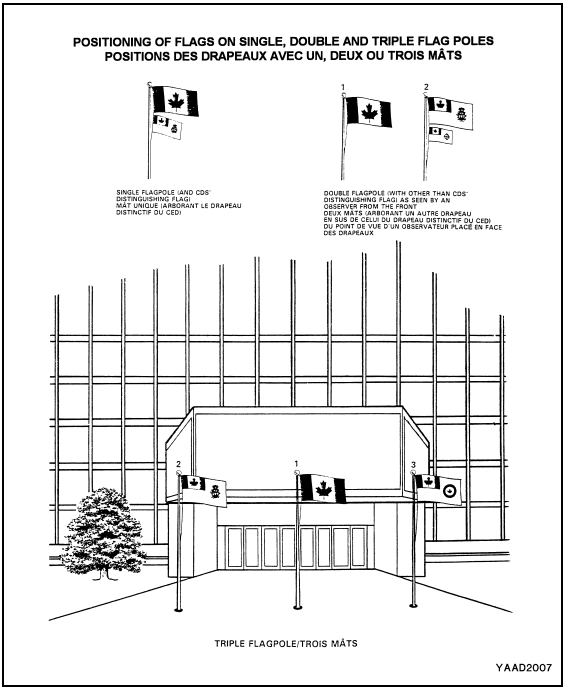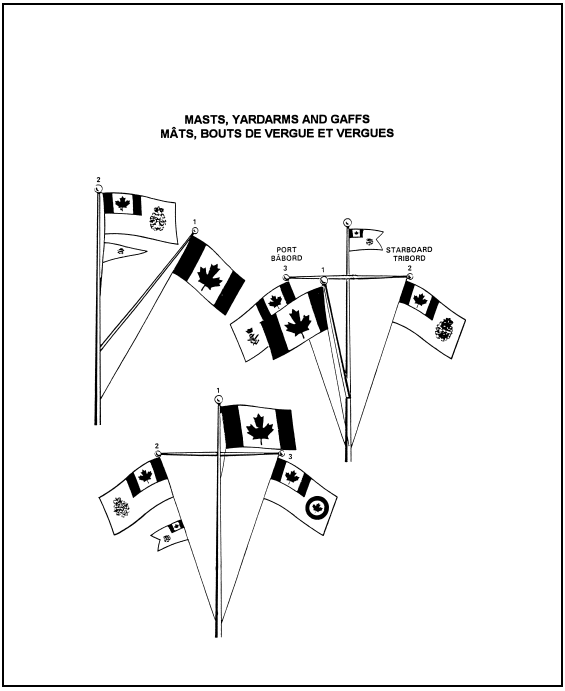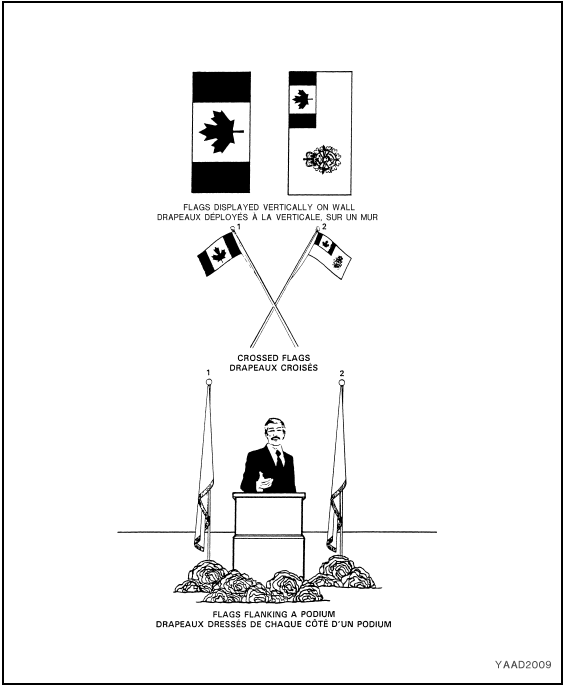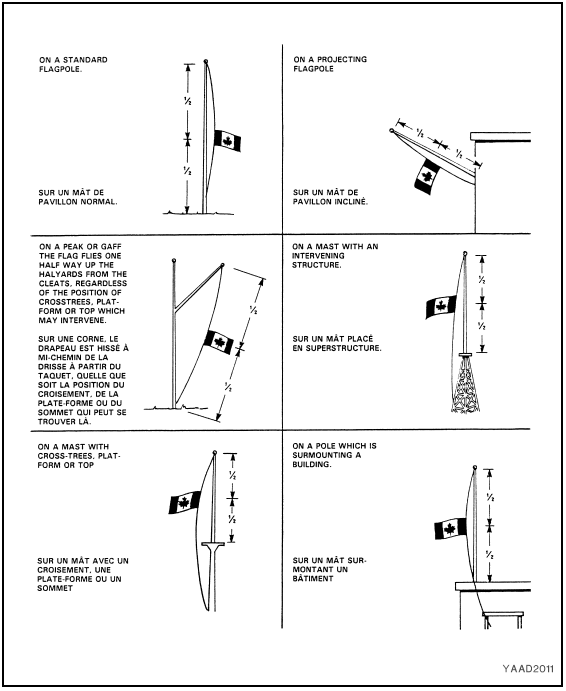Heritage Structure | Section 2 – Flag Usage On Land
Table of contents
- Section 2 – Flag usage on land (4-2-1)
- Precedence and protocol (4-2-1)
- Basic rules (4-2-3)
- Hoisting and lowering at sunrise and sunset (4-2-5)
- Half-masting (4-2-6)
- Ceremonial parades and occasions (4-2-8)
- Breaking of flags (4-2-9)
- Flag ownership and use (4-2-9)
PRECEDENCE AND PROTOCOL
- Flags shall always be flown in order of precedence.
- The order of precedence for Canadian flags, less consecrated Colours, is as follows:
- National Flag;
- Canadian Forces (CF) Ensign;
- command flags;
- field formation flags;
- branch flags; and
- unit flags.
- Other precedence rules are given:
- for flags on vessels, in this chapter, Section 3;
- for personal and distinguishing flags/pennants, in Chapter 14; and
- for CF flags in the same class (e.g., branch flags) flown together, in Chapter 1.
- Flag protocol dictates that the superior and junior positions for flags flown in order of precedence be as illustrated in Figure 4-2-1. The protocol on land visualizes flags as if they are being carried by individuals and being approached from the front, with the flag-bearer’s right taking precedence over the left. Thus:
- When two, or more than three, flags are flown together, the senior flag (the National Flag, if one of the group) shall be displayed on the right, that is, on the left side as seen by a spectator facing the dais, rostrum, saluting base, building, etc., from the front.
- When three flags are flown together, the senior flag shall occupy the central position, with the next ranking flag on its right and the third ranking flag on its left, that is, on the left and right as seen by a spectator facing the flags from the front.
- The protocol for flags on masts (see definition in Section 1, paragraph 4) gives precedence to starboard (right) over port (left), with the direction of the gaff indicating aft (rear). Further:
- The senior position is at the gaff. The precedence of other positions is illustrated in Figure 4-2-2.
- A mast on land which has no gaff does not indicate starboard or port. Thus flags flown from a flagpole with a crosspiece (yard), but no gaff, follow the conventions laid out for right and left in paragraph 4 above.
- When a number of national flags are flown together on flagpoles, the flags are displayed according to the United Nations (UN) order of precedence, that is, in English alphabetical order with the National Flag of Canada taking precedence on Canadian soil. If circumstances make it desirable to show the symbolic equality of the nations involved in a sequence of more than three, a second Canadian National Flag may be displayed at the left end of the line of flags. (When only the flags of BENELUX countries – Belgium, Luxembourg and the Netherlands – are involved, their flags shall be displayed in French alphabetical order.)
- To prevent confusion, flagpoles should be installed at equal heights parallel to building frontages, etc. Existing flagpoles may not conform to this convention, and, where necessary, the following guidelines shall apply:
- where flagpoles are of obviously unequal heights, the highest takes precedence;
- where flagpoles are arranged in a file perpendicular to a building frontage and:
- visitors also approach from the front, the front flag takes precedence,
- visitors clearly approach from one side or the other, the flags greet the visitors in their normal facing order (see paragraph 4); and
- in special circumstances, such as a circular display, the UN rules shall be followed – National Defence Headquarters (NDHQ)/Director History and Heritage should be consulted in these rare cases.
- Where multiple flagpoles are installed but only some are occupied by flags, the empty poles are considered not to exist. Flags count, not poles, and follow normal precedence. (If a distinguishing or other flag is to be broken within a display, care should be taken in arranging the original precedence to avoid needless displacement.)
- If poles are split into two or more obviously separated groups, each group maintains its own internal precedence. For example, the senior group is to the front or right (observer’s left) of a junior group. Thus, a distinguishing or other flag might be broken on a pole separated from a group, e.g. on top of a building or at a saluting dias, without disturbing the precedence within the group.
BASIC RULES
- ChWhen flown or displayed, flags should not be allowed to touch the ground, floor or deck. The CF Ensign and command flags shall never be flown by civilian organizations.
- Flags shall be hoisted or lowered simultaneously if possible. If this is not possible, the National Flag shall be hoisted first and lowered last. When accompanied by a bugle call or a national anthem, the National Flag shall be hoisted in such a manner as to reach the block on the last musical note, or be lowered completely in a similar manner.
- The National flag shall be:
- given the place of honour among other flags inside Canada, except those of the Canadian head of state and representative - see also Section 4, paragraphs 2 and 3; and
- flown in accordance with local regulations and customs at defence establishments outside Canada jointly occupied by Canadian and foreign military forces – see also Section 4, paragraph 3.
- Generally, flags in a set should be approximately the same size and flown at the same height (less the CF Unit Commendation pennant, see Chapter 3, and CF distinguishing flags or pennants, see Chapter 14).
- The flags of two equal organizations, e.g., two national flags or two command flags, shall not be flown one under the other on the same flagpole or halyard, except a defeated national flag in time of war.
- The flags of two unequal organizations may be flown from a single flagpole or halyard, the senior uppermost. Under these circumstances the junior is commonly smaller in size.
- Flags may be displayed flat against a wall either horizontally or vertically. If displayed vertically, the hoist is at the top, and the top of the flag is to the left as seen by spectators (Figure 4-2-3). (Protocol dictates that the "top" and "right" of someone holding a flag – that is, the "top" and "left" as seen from the front by a spectator – are honour sides and take precedence. Thus flags are displayed flat and vertical as if held by an individual backed against the wall with the flag dipped to the right until the pole is horizontal.)
- The National Flag shall be used to drape a closed casket (Figure 4-2-4). No other flag shall be used for this purpose, except:
- other national flags, if appropriate, for foreign personnel whose funeral arrangements are being conducted by the CF; and
- the UN Flag for ceremonies in appropriate operational areas. The UN Flag shall not be used in Canada, and UN headdress shall not be placed on the coffin in Canada.
- Special accounting procedures for the retention of funeral flags by next-of-kin are outlined in A-LM-182-001/JS-001, Supplementary Supply Instructions.
- When flags are lowered or removed from their place of service, they are simply folded with quiet dignity. "Drill" movements and triangular folds shall not be used when lowering or removing flags.
HOISTING AND LOWERING AT SUNRISE AND SUNSET
- At defence establishments and in HMC ships not underway, the National Flag and other flags shall be flown daily from sunrise to sunset.
- The timings for hoisting and lowering flags to mark sunrise and sunset within Maritime Command may be established by its commander in accordance with traditional naval practice irrespective of calendar time, normally:
- Where practicable, 0800 hours ("colours") to sunset, including when the sun rises after 0800 hours;
- Where the above is impracticable, during normal working hours; and
- At locations where there is continuous daylight or darkness, from 0800 hours to 1700 hours.
- When the National Flag or other flags are flown or displayed at night by the CF in accordance with the above paragraph or on special occasions, they shall be properly illuminated.
HALF-MASTING
- Flags will only be half-masted on flagpoles fitted with halyards and pulleys. Some flags are permanently attached to and flown from horizontal or, in a floor display, angled poles, without halyards. Flags on these will not be half-masted.
- Unless special instructions are received, all flags shall be half-masted at all defence establishments and HMC ships (see Figure 4-2-5) from the time of notification of death until sunset on the day of the funeral or the memorial service upon death of:
- the Sovereign, the Governor-General or the Prime Minister;
- a member of the Sovereign’s family;
- a former Governor-General;
- a former Prime Minister;
- DELETED
- a Chief Justice of Canada and members of the Canadian Ministry;
- Privy Councillors and Senators; and
- as directed by NDHQ/National Defence Command Centre (NDCC).
- Within a province, unless specific instructions are received, all flags shall be half-masted at all defence establishments and HMC ships from the time of notification of death until sunset on the day of the funeral. If a memorial service is to be held, halfmasting should take place from the time of notification of death until sunset the following day and from sunrise to sunset on the day of the memorial service upon the death of:
- the Lieutenant-Governor;
- the Premier;
- Cha Privy Councillor who is not a current member of the Ministry or a current Senator within his/her place of residence;
- Cha member of the House of Commons or member of the Provincial/Territorial Legislature within his/her riding; or
- Chas directed by NDHQ/National Defence Command Centre (NDCC).
- ChIn the event of the death of a member of the CF who is deployed on operations to a Special Duty Area, unless specific instructions are received, flags shall be half-masted as follows:
- Chall flags within the Task Force to which a member is assigned at the time of death shall be half-masted from the day of death until sunset the day of the funeral;
- Chall flags at the home/base station of the member shall be half-masted from the day of death until sunset the day of the funeral;
- Chall flags within the Environment (Sea, Land and Air) to which the member was assigned shall be half-masted from sunrise to sunset on the day of the funeral; and
- Chall flags at NDHQ (101 Colonel By Drive only) and at the headquarters of the operational command to which a member is assigned at the time of death shall be half-masted from the day of death until sunset the day of the funeral.
- Flags shall be flown at half-mast on other occasions when ordered by NDHQ/NDCC, and during the funeral of a service member being held at a particular unit or in a ship. Command headquarters may also order flags to be flown at half-mast. When the order is to be issued command-wide it will be issued by NDHQ/NDCC to ensure CF-wide coordination. For a funeral on land, flags shall be halfmasted when the funeral procession is due to leave the place where the remains have been lying and hoisted when sufficient time has elapsed for the interment.
- ChDELETED
- When flags are ordered to be half-masted throughout the day, they shall first be hoisted close-up and then immediately lowered slowly to half-mast. At sunset they shall be hoisted close-up, then lowered. (These procedures do not apply while flags are halfmasted for the death of the Sovereign, when they are only raised to full-mast for the day on which the accession of the new Monarch is proclaimed.)
- On occasions requiring that one flag be flown at half-mast, the other flag(s) in an array should also be flown at half-mast. In HMC ships especially, when the Ship’s Ensign is worn at half-mast, the jack, if worn, shall also be half-masted. (Except as prescribed in Chapter 14, Section 3, paragraph 15, the position of distinguishing flags flown from a mast fitted with a gaff is not altered. The protocol for a funeral at sea is noted in Section 3.)
- Foreign national flags flown with the National Flag shall also be half-masted.
- Her Majesty’s Personal Canadian Flag and standards of members of the Royal Family are never half-masted.
- When foreign flags are flown on bases and stations where foreign personnel are training or serving on permanent duty, they shall be half-masted on the day of the funeral of their head of state or as directed by their national government.
CEREMONIAL PARADES AND OCCASIONS
- Only the following Canadian flags may be carried on parade:
- consecrated Colours (see Chapter 5);
- Chofficial commemorative (Royal) banners (see Section 7, paragraph 1);
- the National Flag;
- the CF Ensign; and
- command flags.
- Branch, field formation, regimental, service battalion and other camp flags shall not be carried on parade.
- On ceremonial parades, including guards of honour, the National Flag may only be carried if consecrated Colours are not being carried by the unit concerned. Units shall only carry one National Flag. Normally, the National Flag is carried by a senior noncommissioned officer and has no escort, but may be accompanied by an armed escort, if the personnel on parade are armed. The National Flag shall be saluted as for consecrated Colours. The National Flag shall not be dipped or lowered by way of salute or compliment. The CF Ensign or a command flag, as appropriate for the occasion, may be carried with the National Flag.
- The CF Ensign and command flags may be carried on parade within the following guidelines:
- they shall not be carried if consecrated Colours are also being carried by the unit concerned;
- they may be paraded with the National Flag;
- Chthey may be paraded with guards of honour as noted in Chapter 13, Annex A and A-PD- 201-000/PT-000, CF Manual of Drill and Ceremonial;
- Chby themselves they are not entitled to, and shall not be attended by, an armed escort – they may have such an escort when accompanying the National Flag if it has an armed escort; and
- Chthey shall not be carried of flown by civilian organizations.
- Compliments (salutes) shall only be paid to consecrated Colours and the National Flag. They shall not be paid to any other Canadian flag.
- On combined parades, each separately identified unit or contingent may carry its own set of flags; e.g., for a Remembrance Day parade, a veterans’ contingent with Royal Canadian Legion flags, a naval contingent with a National Flag and a Maritime Command Flag, an infantry battalion with its stand of Colours, and a flying squadron with its Standard.
- On international parades in Canada, only the flags of countries having a contingent involved in the parade shall be carried. The flag of each country shall be carried by its own service personnel in accordance with its own regulations.
BREAKING OF FLAGS
- Instructions for breaking flags are illustrated in Figure 4-2-6.
ChFLAG OWNERSHIP AND USE
- Flags of the former Canadian services flown or used prior to the creation of the Canadian Forces in 1968, are not authorized to be used in the CF, except:
- camp flags as noted in Section 5; and
- flags previously used as a type of distinguishing flag or pennant for regimental appointments.
- ChCurrent CF flags are protected under copyright and trademark laws of Canada. The Department of National Defence also retains copyright on and reserves permission to fly, use, or show any flag, pennant or banner previously authorized or used by or within any formation of the former Canadian armed services existing until creation of the CF in 1968. Permission must be obtained from NDHQ/DHH (Inspector of CF Colours and Badges) prior to any group, association, or person outside of the CF making use of current or previous CF flags.

Figure 4-2-1 Positioning of Flags

Figure 4-2-2 Positioning of Flags on Masts

Figure 4-2-3 Positioning of Flags Horizontally or Vertically

Figure 4-2-4 Draping of Flag on a Closed Casket

Figure 4-2-5 Half-masting of Flags

Figure 4-2-6 Preparation of distinguishing Flags for Breaking